Flight Search
UX/UI
Expedia Save and Compare
Improving discoverability and helping users make faster, informed flight booking decisions
The Challenge
Users often feel overwhelmed, lose track of their selections, and ultimately miss out on the best deals.
The Objective
How might we create a more intuitive flight comparison experience on Expedia, allowing users to seamlessly track and organize their travel choices without feeling overwhelmed or frustrated?
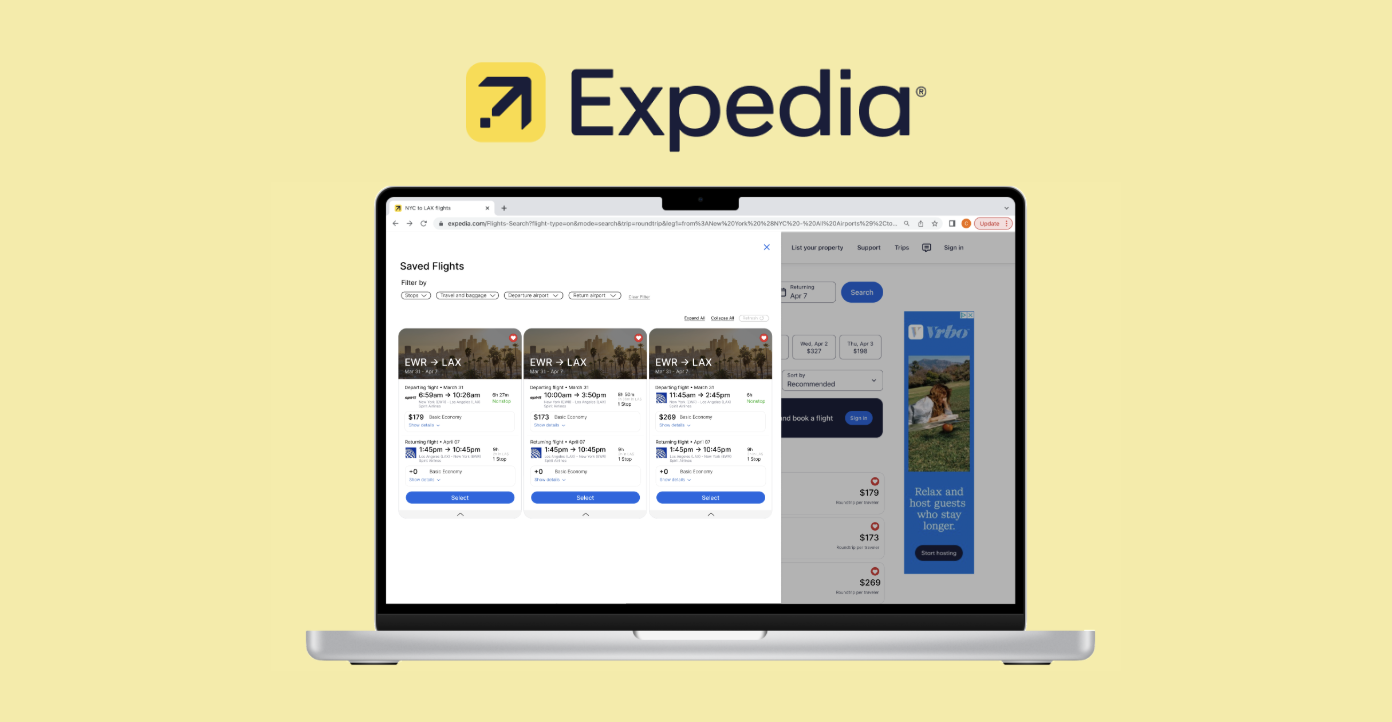
Timeline
4 Weeks
Role
UX/UI Designer
Skills
User Research, Journey Mapping, Prototyping, Usability Testing
The Problem
Rethinking Flight Comparison on Expedia
Expedia helps millions of travelers book flights every year, but the comparison experience falls short. Without a clear, intuitive way to evaluate options, users often feel overwhelmed, lose track of their selections, and ultimately miss out on the best deals.
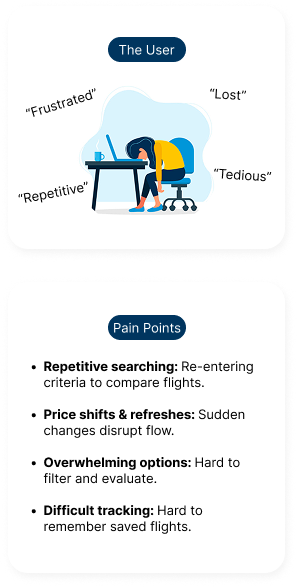

Solution
Simplifying Flight Choices
Therefore, by introducing a streamlined flight-saving and comparison feature, it aimed to help users track options with ease.
Browse and Safe Flights
A real-time flight saving feature for better decision making.
Jump to Final Design
Discovery & Research
Understanding the Problem
To start, in order understand the pain points and uncover opportunities for improvement, I mapped out a research plan that included user interviews and competitive analysis. I wanted to know:
1
How are users currently planning trips and comparing flights?
2
What are the frustrations they face when using Expedia to book their flights?
3
Why do they choose Expedia over other platforms?
User Interview Overview
I conducted 1:1 user interviews and send out surveys to the targeted users.
Demographic:
Current users aged 19-23
Looking for budget friendly flights
Demographic:
Current users aged 19-23
Looking for budget friendly flights
Research methodologies:

Key Findings
Multi-Tab Comparison
73%
use multiple tabs/sites to compare flights
(17 out of 23 survey respondents)
(17 out of 23 survey respondents)
Losing Track of Flights
81%
reported difficulty returning to a flight
(9 out of 11 interviews)
(9 out of 11 interviews)
External Tools Usage
57%
rely on external tools to save or compare
(13 out of 23 survey respondents)
(13 out of 23 survey respondents)
Insight 1
Users often have multiple tabs open and switch between sites to compare prices and options.
“I feel like I have 10 tabs open just trying to see which site has the best deal.”
“I have to check 3 or 4 other sites at the same time, otherwise I’m worried I’ll miss a better price.”
“I have to check 3 or 4 other sites at the same time, otherwise I’m worried I’ll miss a better price.”
Insight 2
Once they find a flight they like, it can be difficult to return to that specific option after navigating away from the page.
“It’s really annoying when I find a good flight, but then I can’t get back to it easily.”
“If I click away for even a second, I lose the flight I wanted and have to search all over again.”
“If I click away for even a second, I lose the flight I wanted and have to search all over again.”
Insight 3
Many users resort to external tools like Google Flights, notes apps, or screenshots to compare flights.
“I just end up taking screenshots to remember which flights I liked.”
“I actually use Google Flights to compare, then come back to Expedia to book.”
“I actually use Google Flights to compare, then come back to Expedia to book.”
Therefore...
Problem Statement
How might we create a more intuitive flight comparison experience on Expedia, allowing users to seamlessly track and organize their travel choices without feeling overwhelmed or frustrated?
Defining Users
Who are we designing for?
Before going into brainstorming solutions, I created a user persona to understand our target user based on insights from the initial user research. Meet Molly, a college student who is interested in quickly finding budget friendly flights that matches with her travel plans.
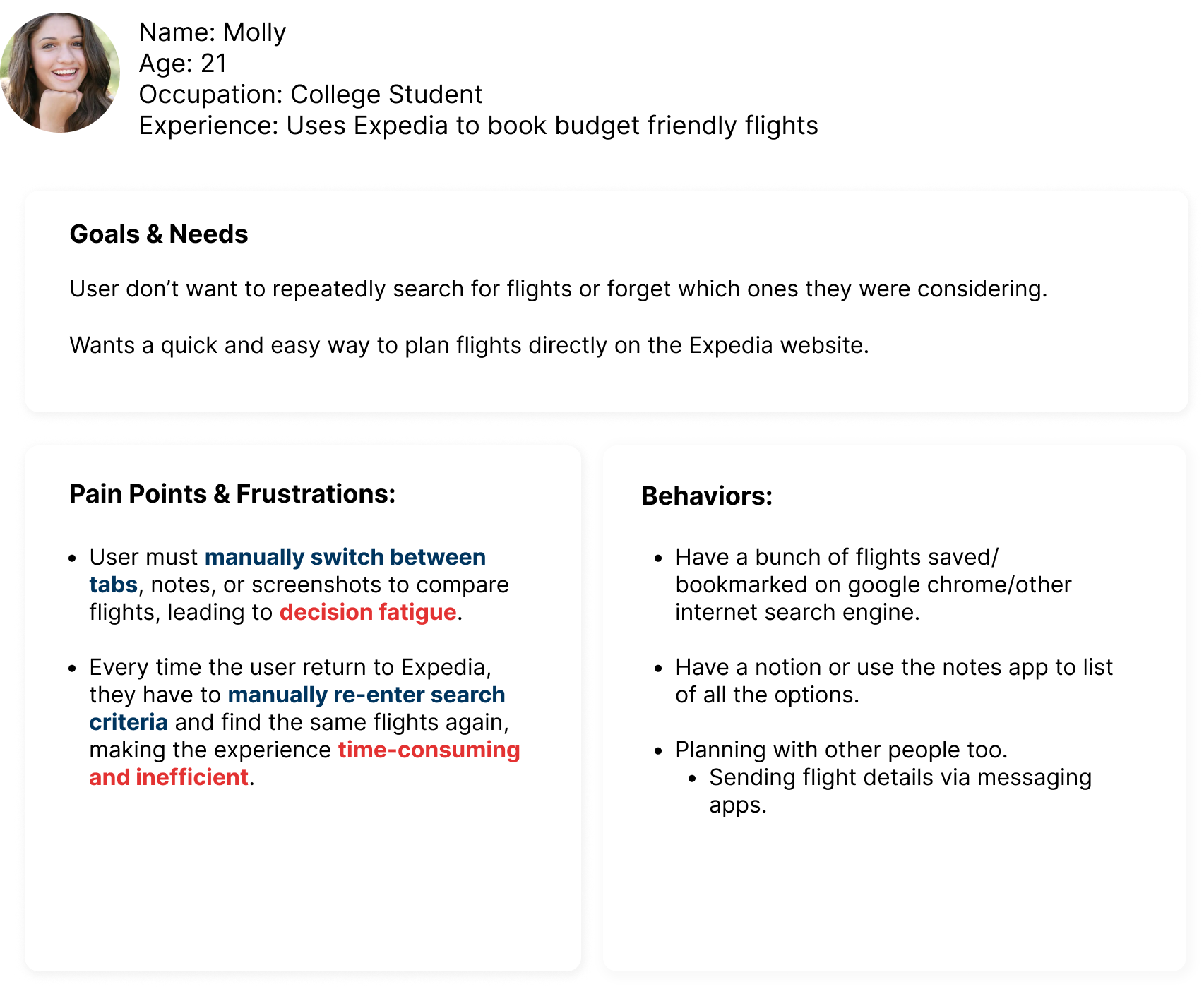
Journey mapping
In addition to a user persona, I mapped out what Molly potentially says, thinks, feels, and does during the flight search process. The key here to is identify the low points and pain points along the way.
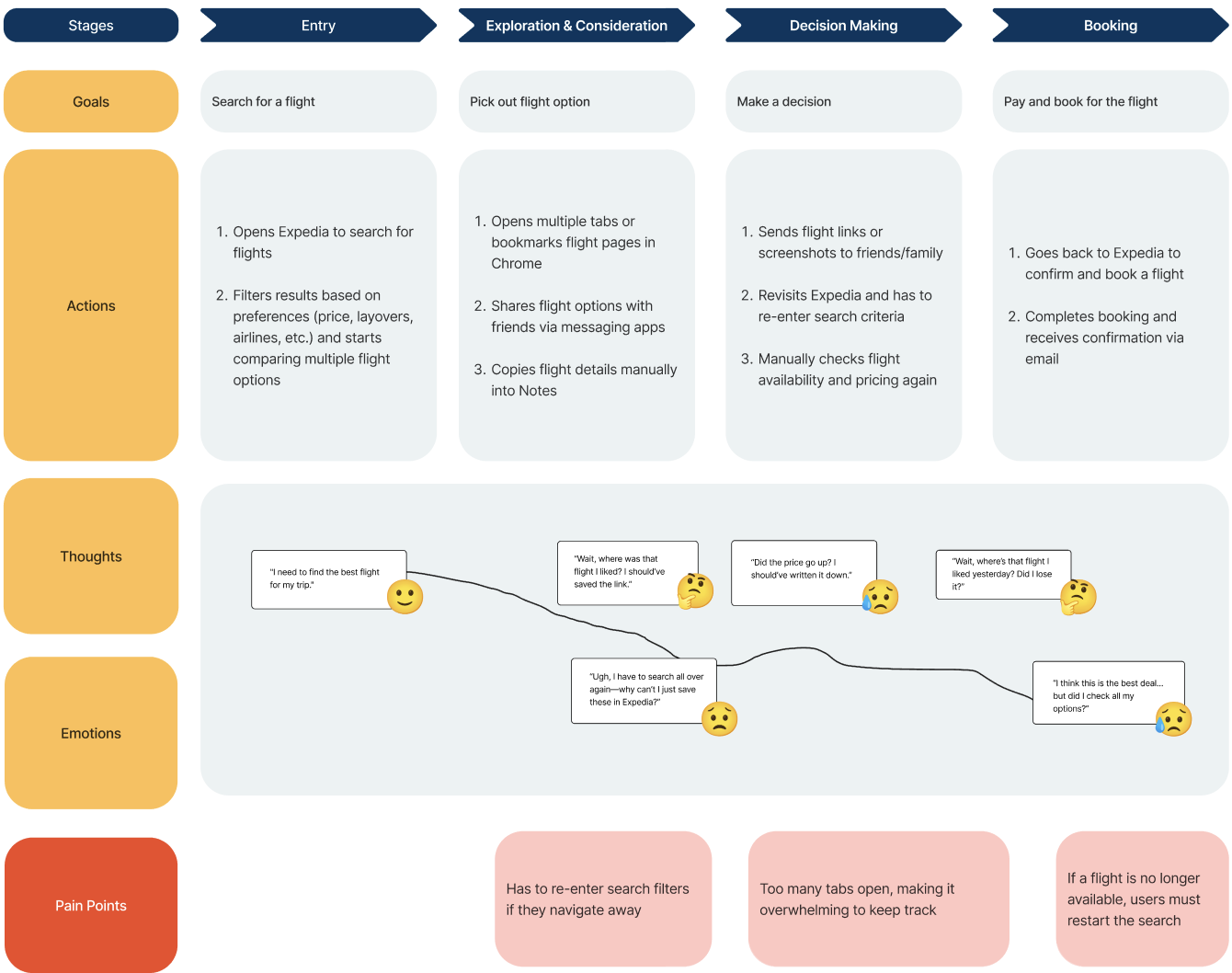
Ideating
Looking for the best option
With the insights in hand, I began brainstorming solutions to improve the flight comparison process on Expedia. The key challenge was to create a feature that allowed users to evaulate flights options seamlessly without disrupting their workflow.
I explored multiple options, including:
- Flight Comparison Tool: A built-in tool to compare flights side-by-side.
- Price Alerts: Notifications when prices changed.
- Rating System: Helps users spot top rated flights quickly.
I explored multiple options, including:
- Flight Comparison Tool: A built-in tool to compare flights side-by-side.
- Price Alerts: Notifications when prices changed.
- Rating System: Helps users spot top rated flights quickly.
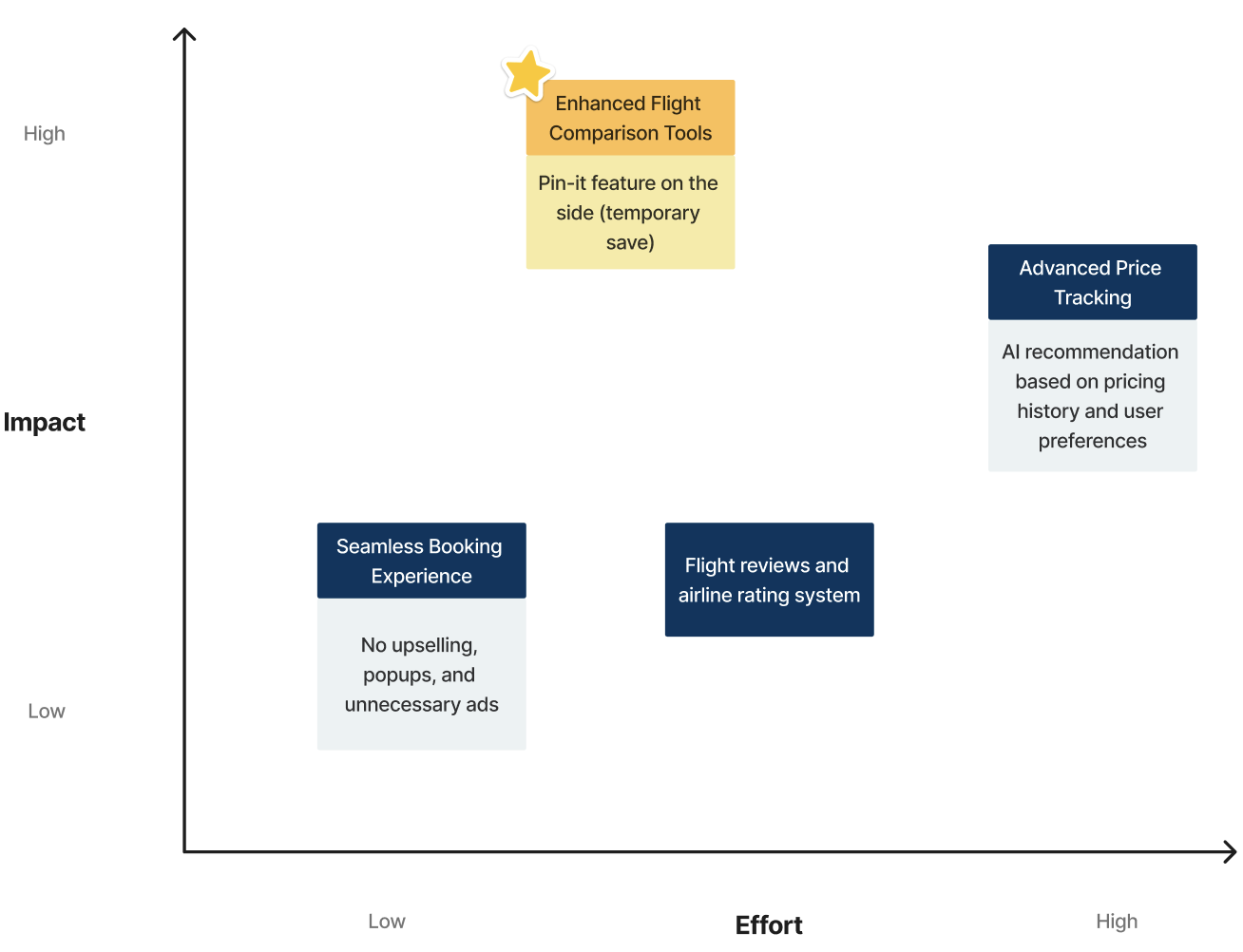
Envisioning the New User Flow
Then I reimagined the user flow with the new feature and how it would help minimalize the frustration of going back to the beginning of the search process.
With the new “Pin It” feature:
- Users can save and pin flights directly during the search process.
- After navigating through different stages of the site, users can access their pinned flights list and compare options easily without losing track of previous selections.
With the new “Pin It” feature:
- Users can save and pin flights directly during the search process.
- After navigating through different stages of the site, users can access their pinned flights list and compare options easily without losing track of previous selections.

Before
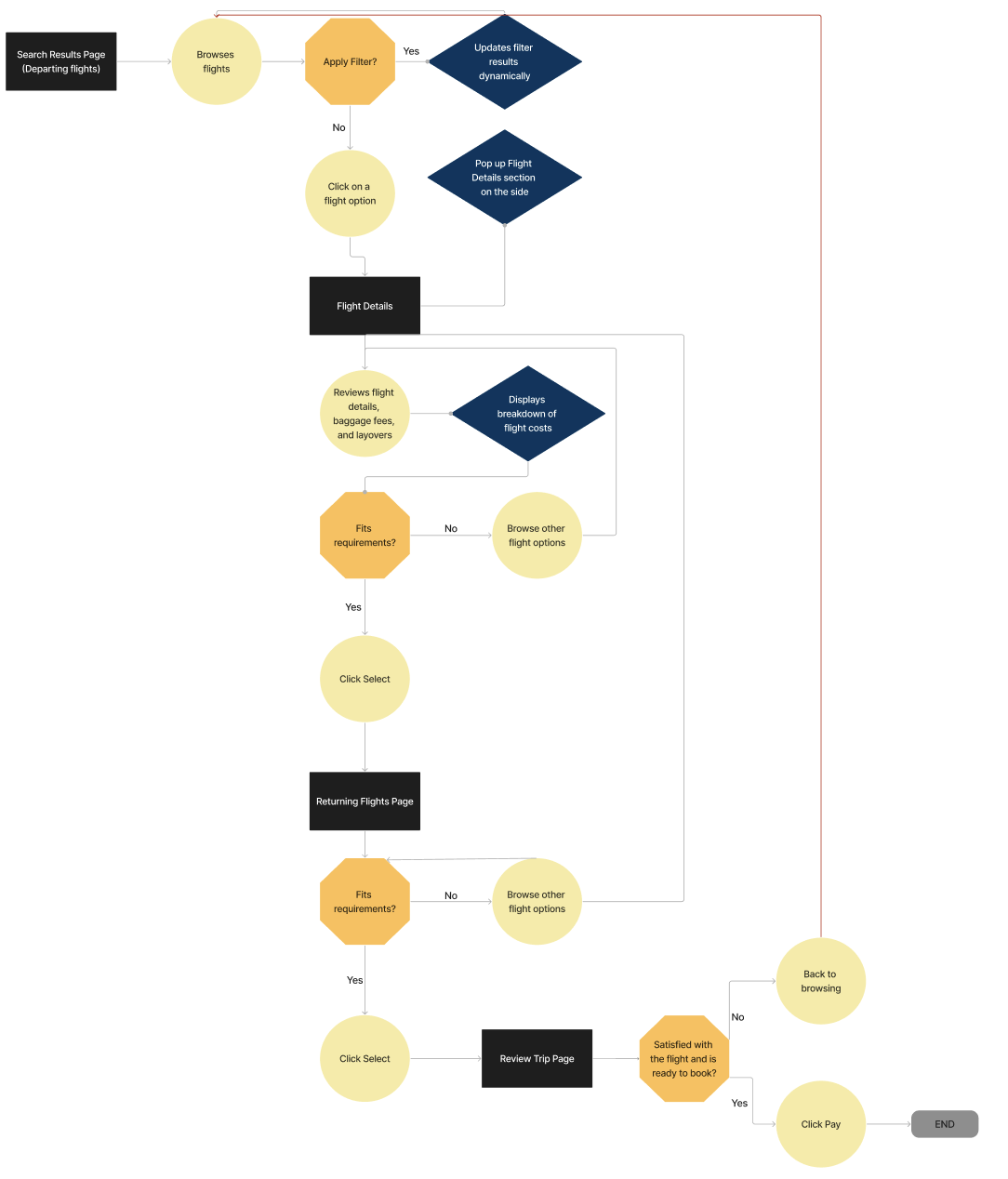
After

Wireframing & User Testing
Initial Wireframes And user Testing
Before moving on to digital wireframes, I quickly sketched out some low-fidelity paper wireframes that showcased how the “Pin It” feature would integrate into the flight search experience. This way I can get quickly get ideas out receive some initial feedback before building the design on Figma.

After going through a quick round of user feedback, these are the UI changes made to the initial lo-fi wireframes.
Before
After

Transitioning from Mid-fi to Hi-fi



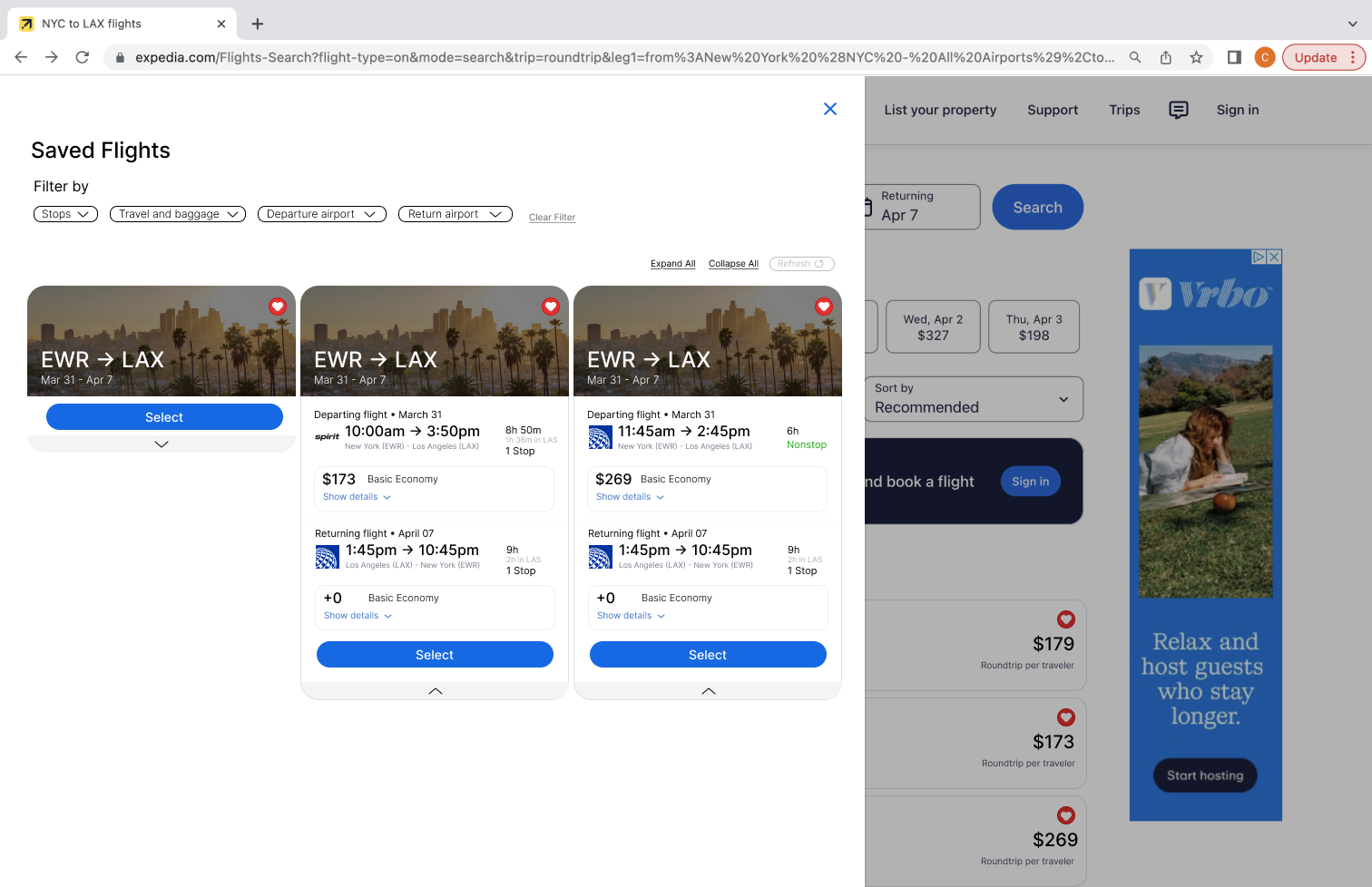
Reflection
What I learned
1. Testing Early: Rapid prototyping and user feedback helped me refine the interface especially around visibility, usability, and how comparison data was displayed.
2. Iterating with Constraints in Mind: Working within Expedia’s existing design system taught me how to ideate creatively while respecting branding, UI consistency, and technical feasibility.
3. Scoping for MVP: I practiced scoping features for a minimum viable product, prioritizing functions that solve the core user problem while leaving room for future enhancements.
2. Iterating with Constraints in Mind: Working within Expedia’s existing design system taught me how to ideate creatively while respecting branding, UI consistency, and technical feasibility.
3. Scoping for MVP: I practiced scoping features for a minimum viable product, prioritizing functions that solve the core user problem while leaving room for future enhancements.
The Problem
Low Engagement Despite Interest
Although TikTok Shop has seen success with deals and affordable pricing, only 29% of weekly users have made a purchase. Meanwhile, 26% are interested but have not made a purchase, revealing a crucial gap between interest and action.

This hesitation presents both a trust barrier and a missed opportunity for TikTok to convert engaged users into active buyers.
User Research
User Interview Findings
So to understand what drives user behavior, we conducted interviews with both existing TikTok users and newcomers to TikTok Shop. Our goal was to uncover pain points that prevent or disincentivize users from making purchases.
Here are some key takeaways:
Existing Brand Loyalty:
Many users are already loyal to platforms and stores they frequently shop from.
Social Proof & Trust:
Users expressed hesitation due to a lack of social proof. Since they don’t know anyone who uses TikTok Shop, they see no compelling reason to try it.
Membership & Perks:
Users would use the same platforms because they see value in loyalty programs and memberships.
Quote Highlight:
“I like scrolling through TikTok, but I’ve never actually bought anything from the Shop. It doesn’t feel trustworthy yet.” — Interview participant
User personas
Then, based on interview data and behavioral trends, we identified two key personas:
Curious Customer:
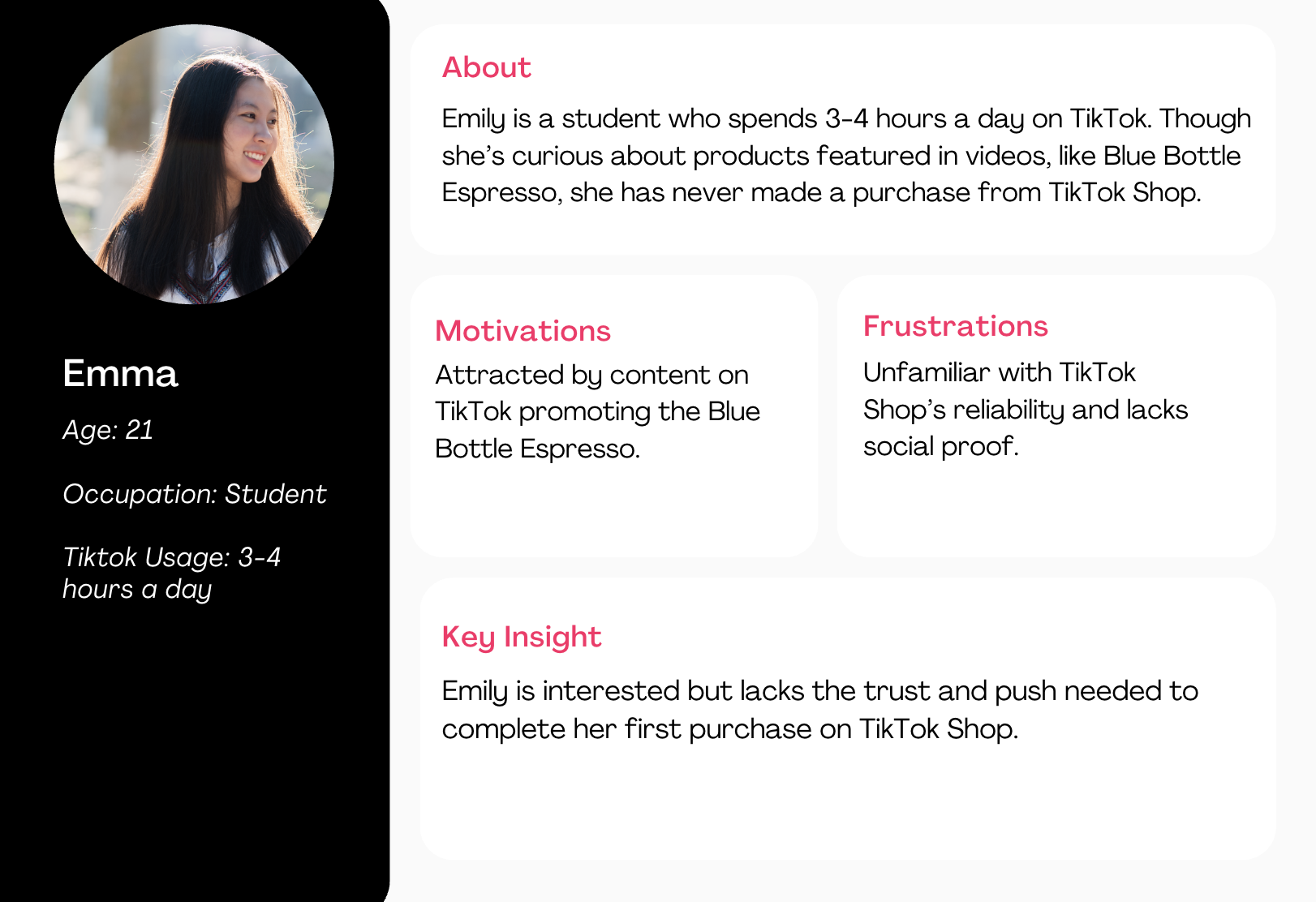
Returning Buyer:
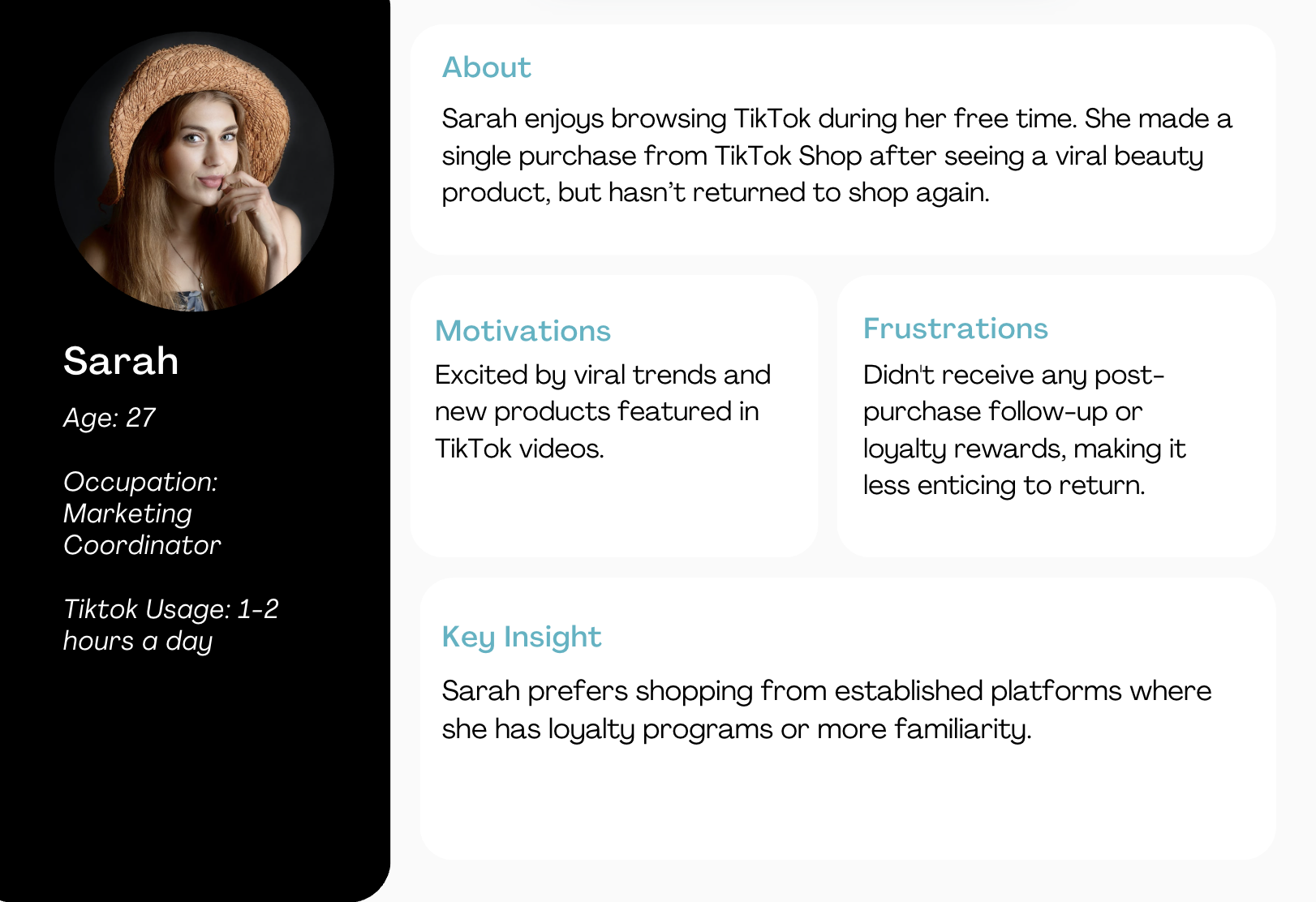
Competitive analysis: What Keeps Customers Coming Back?
Building on our user personas, we explored what keeps customers coming back to other successful e-commerce platforms. Beyond the typical use of coupons and discounts, we found that many brands rely on rewards programs and loyalty systems to drive customer retention and incentivize repeat purchases.
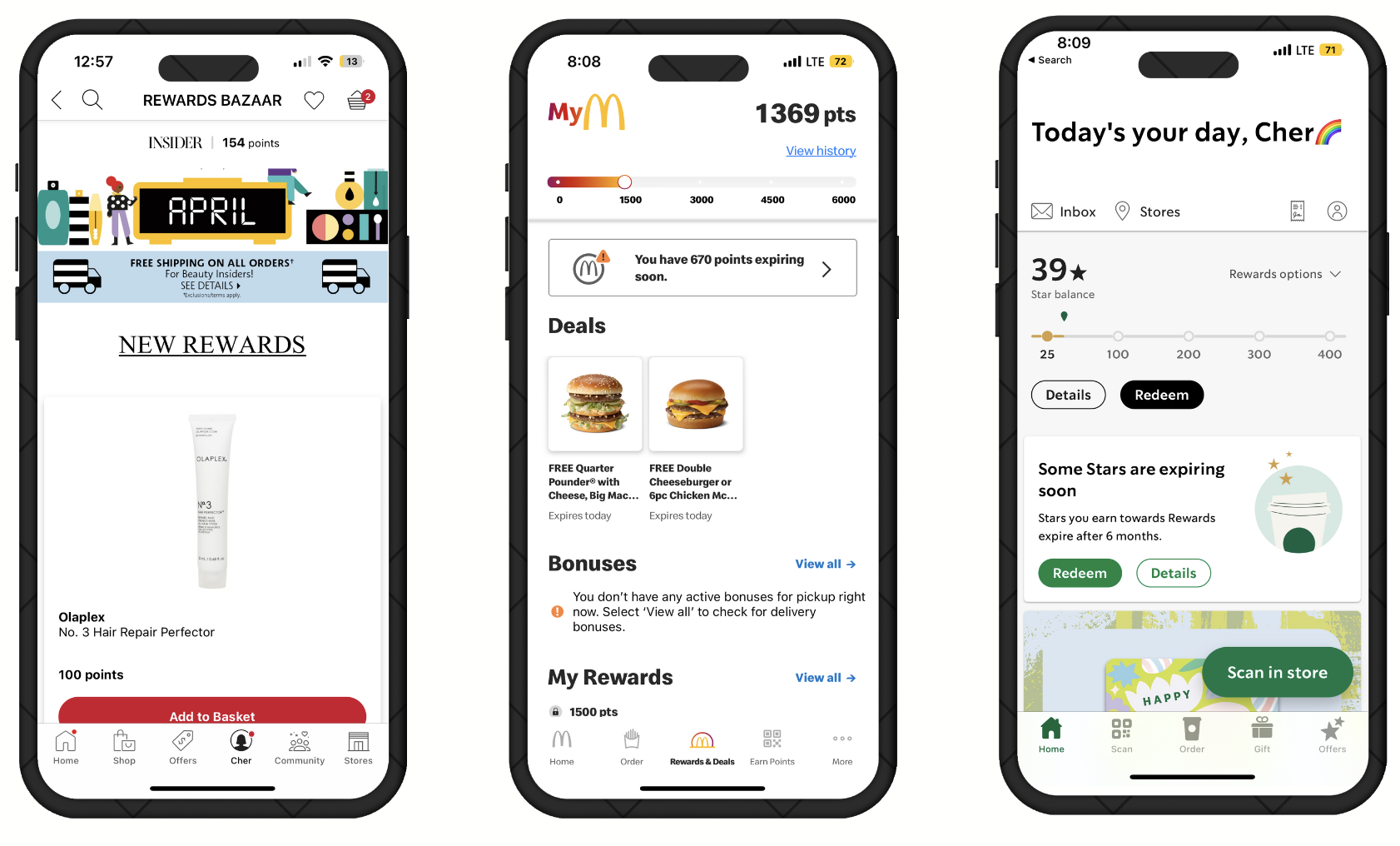
We studied reward systems in apps like Sephora, Mcdonalds, and Starbucks. Common retention strategies included:
Points per purchase
Social Proof & Trust
Membership & Perks
First-time buyer rewards
💡 Key Insight: Trust and Loyalty Are the Biggest Drivers of Conversion
Users are unlikely to make the switch unless TikTok Shop delivers personalized value and a sense of trust. Without recognizable benefits or confidence in the platform, there’s little motivation for users to take action.
🤔 Which leads to the question...
How might we build trust on Tiktok shops, driving increased customer retention rates and attracting new customers?
Ideation
Integrating a Reward System into TikTok Shop
To bring our concept to life, we mapped out a user flow that demonstrates how a reward system could be seamlessly integrated into the TikTok Shop experience. The flow highlights how the system would be:
- Introduced to users
- Reinforced through repeat actions
- Used to build loyalty over time
- Introduced to users
- Reinforced through repeat actions
- Used to build loyalty over time
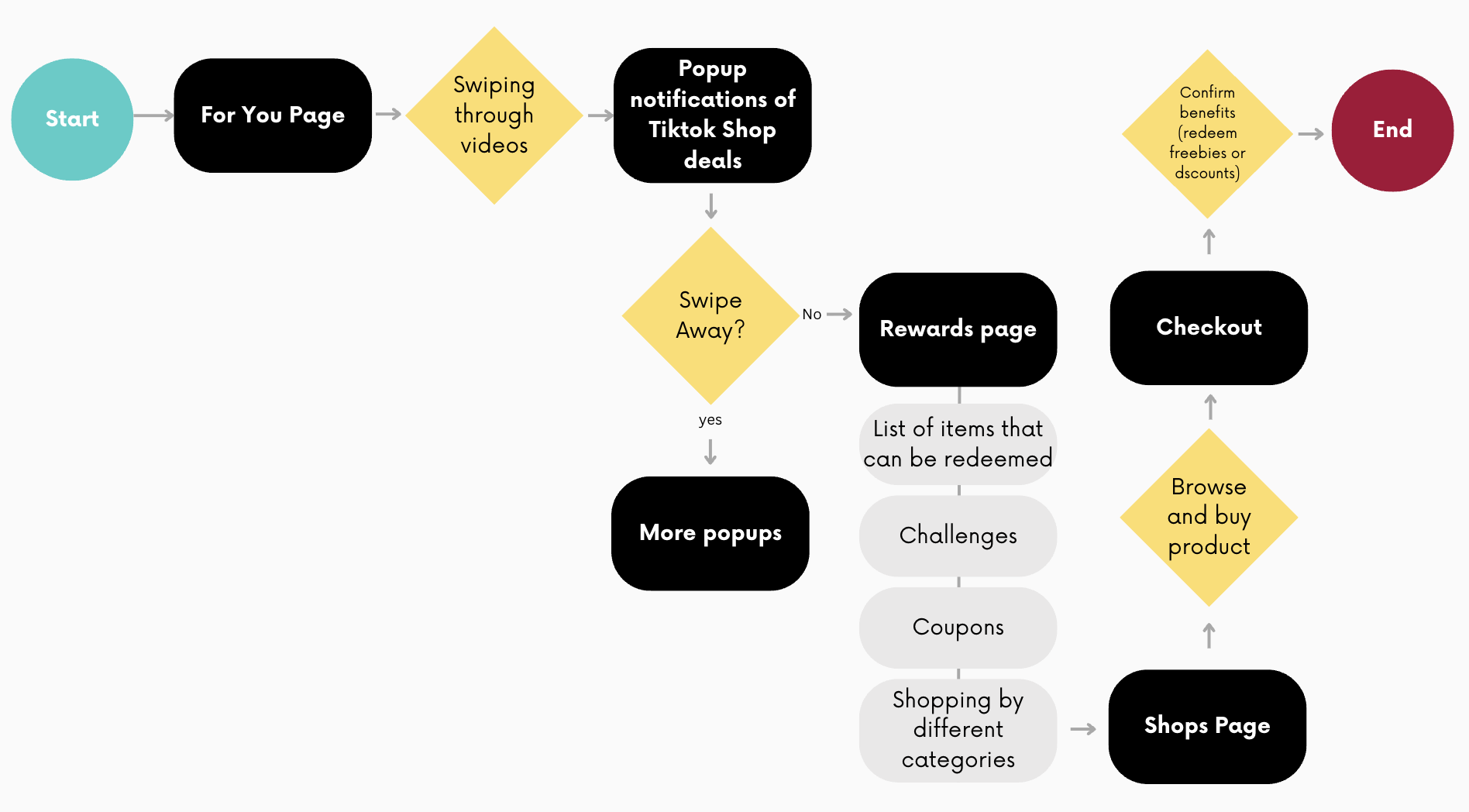
Wireframing
Low fidelity wireframes
To quickly explore and communicate our ideas, we created a set of low-fidelity wireframes in Figma. Key elements include:
- Onboarding moments where the reward system is introduced to users
- Incentive touchpoints that encourage repeat purchases (e.g. points tracker, progress bars)
- Loyalty dashboard allowing users to track and redeem their rewards
- Onboarding moments where the reward system is introduced to users
- Incentive touchpoints that encourage repeat purchases (e.g. points tracker, progress bars)
- Loyalty dashboard allowing users to track and redeem their rewards

Working Prototype #1
This interactive version allowed users to experience key features such as earning points, tracking progress, and redeeming rewards.
To evaluate its effectiveness, we conducted a formal round of usability testing with participants from our target user groups assessing:
- Clarity of how the rewards system is introduced
- Ease of navigation through the rewards interface
- User motivation to engage with the system repeatedly
To evaluate its effectiveness, we conducted a formal round of usability testing with participants from our target user groups assessing:
- Clarity of how the rewards system is introduced
- Ease of navigation through the rewards interface
- User motivation to engage with the system repeatedly

Usability Testing
Testing results and iterations
Here are some key pivots/changes we made according to the user test:
Feedback #1: "The Pop-Ups makes it feel like a scam!”:
Before
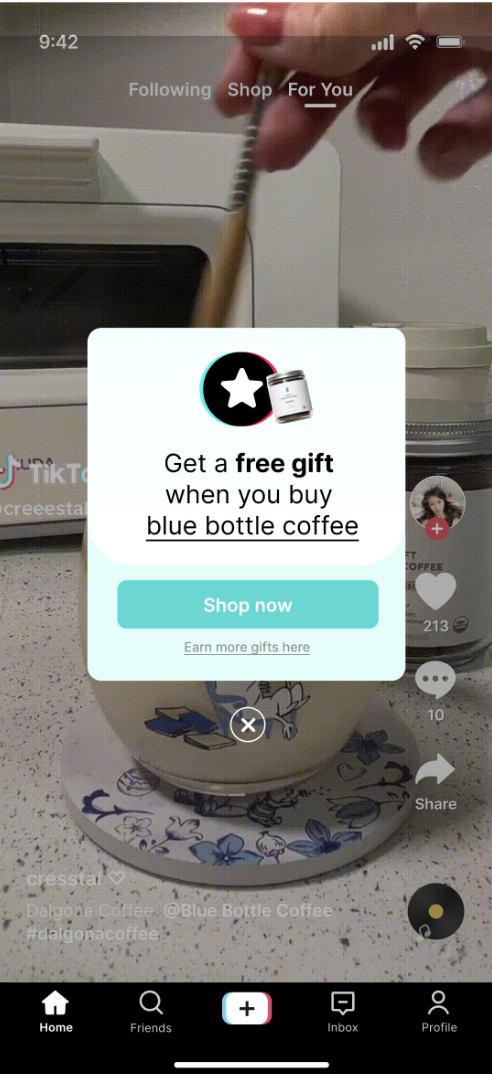
20%
Clicked on the popup
After
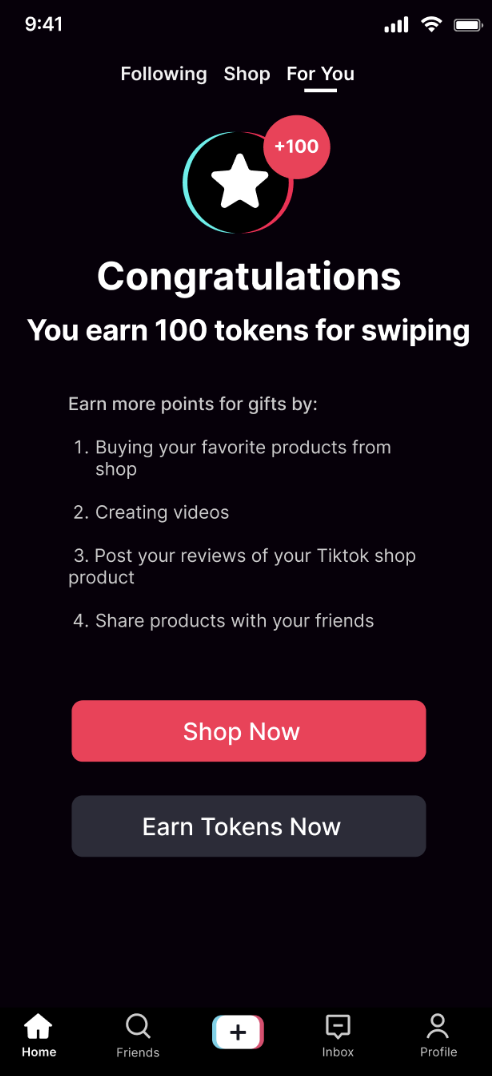
50%
Clicked on the popup
Subtle Reward Reminders on FYP:
-> Replaced intrusive pop-ups with a subtle announcement screen
-> Periodically featured on the For You Page (FYP)
-> Replaced intrusive pop-ups with a subtle announcement screen
-> Periodically featured on the For You Page (FYP)
Feedback #2: Prioritizing Buttons
Before

Interacted with the Rewards System
50%
After
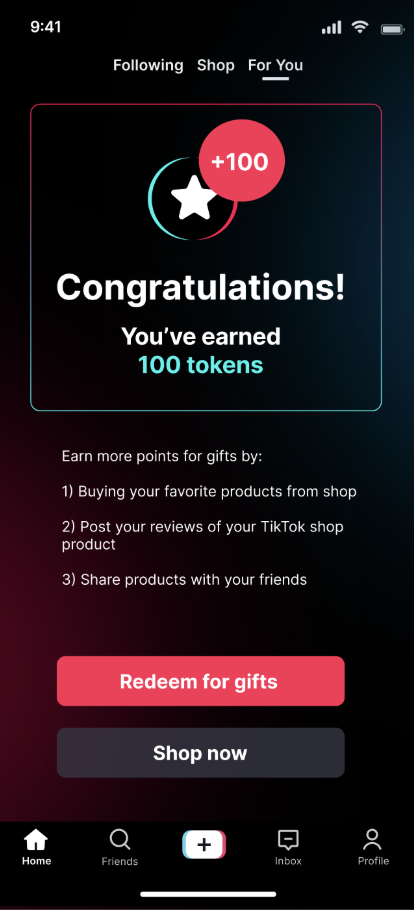
80%
Interacted with the Rewards System
UI Design + Button Change:
-> Prioritize the “Earn Token” button instead of the “Shop now”
-> Consolidating the UI design to get key information across
-> Prioritize the “Earn Token” button instead of the “Shop now”
-> Consolidating the UI design to get key information across
Result
Success?
Our approach showed positive results, as shown by the following user feedback:
80%
Expressed interest in the rewards system
70%
Bought a product because of the rewards feature
Therefore, we ultimately achieved our goals by:
1. Hooking users in and discovering Tiktok Shop
2. Encouraging users to make their first purchases
1. Hooking users in and discovering Tiktok Shop
2. Encouraging users to make their first purchases
Lastly, Introducing...Tiktok shop Rewards!
To bridge the trust gap and encourage first time purchases, we proposed a rewards system designed to build confidence, incentivize engagement, and retain users over time.
FYP Page: Discovery
Discover Tiktok Shop's new rewards system!
Discover Tiktok Shop's new rewards system!
Rewards Page: Engagement
Check out fun challenges, gain Tokens, and earn gifts for free.
Check out fun challenges, gain Tokens, and earn gifts for free.
Shop and Share: Social Trust
Buy and share products with friends!
Buy and share products with friends!
Checkout with gifts: Loyalty
Lastly, complete milestones through shopping and earn benefits including freebies and discounts!
Lastly, complete milestones through shopping and earn benefits including freebies and discounts!
Reflection
What I learned
1. Don't follow assumptions: It is okay to pviot. I learned to question my initial assumptions and let user feedback guide the direction. Instead of focusing on earning points, insights showed users cared more about the reward redemption experience, which led us to pivot our design for greater impact.
2. Design with clarity: I learned that even small visual or wording changes can influence how users feel about completing tasks. For example, by simplifying reward tiers and adding clearer progress cues, we made users feel more motivated and in control of their goals. This is something I will keep in mind in my future designs.
2. Design with clarity: I learned that even small visual or wording changes can influence how users feel about completing tasks. For example, by simplifying reward tiers and adding clearer progress cues, we made users feel more motivated and in control of their goals. This is something I will keep in mind in my future designs.

